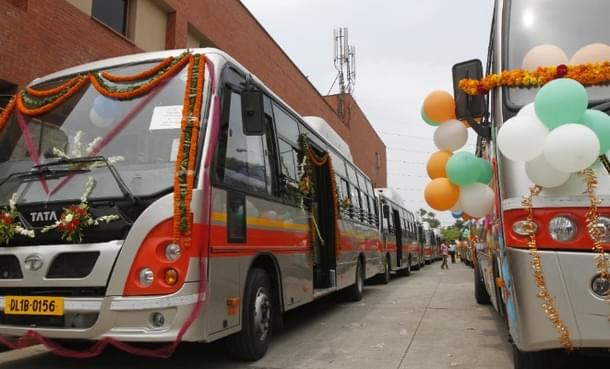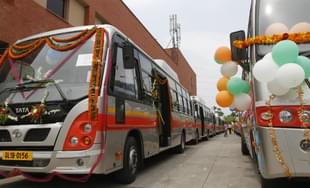Ideas
Why Delhi Metro’s New Feeder Bus Plan Is Worth Emulating Across Cities
Srikanth Ramakrishnan
May 13, 2018, 02:27 AM | Updated 02:27 AM IST
Save & read from anywhere!
Bookmark stories for easy access on any device or the Swarajya app.


The Delhi Metro Rail Corporation (DMRC) recently unveiled a new plan to procure minibuses that would act as feeder services for the 252km-long mass transit line running across the National Capital Region (NCR). The feeder buses will have 16 seats and air-conditioning, and will accept smart cards used on the city metro, sans a conductor. The buses will be operated on the city’s existing cluster model, wherein corporate players run buses under the Delhi Transit banner.
The DMRC’s rationale behind the new model is rather simple – existing feeder buses are in a poor condition and operate on long routes, so they lose relevance as feeder buses. The corporation has also planned to limit the operational distance of buses to a maximum of 6km. It has said that allowing metro smart cards for ticket purposes would ensure that metro users would get on board, but this simply turns out to be a step closer towards a common mobility card.
Why this proposal is a good idea
1) Every city in India needs minibuses. The most common feature of every Indian city is the lack of road space. Many localities in suburban Bengaluru, for instance, were originally villages that were absorbed into the city. The erstwhile village roads are too narrow to handle large buses, and the lack of minibuses resulted in the rise of carpooling platforms such as OlaShare and UberPool.
The Metropolitan Transport Corporation (MTC) in Chennai operates minibuses (branded as “small bus”) in areas with lesser footfalls and narrow roads. The Brihanmumbai Electricity Supply and Transport (BEST) undertaking in Mumbai too operates mini and midibuses on short routes connecting railway stations to nearby localities. The city is now looking at procuring 400 minibuses – 200 air-conditioned and non-air-conditioned each – along with 50 midibuses.
While many cities are looking at acquiring land to build wider roads and better transport infrastructure, these are long-term solutions, and minibuses can help in the short and medium terms.
2) Minibuses offer flexibility. They are cheaper to procure, take up relatively less space on the roads, and still carry more passengers than a cab, and can be used during the off-peak hours when the demand is lower. High-capacity systems such as metro rail, bus rapid transit, monorail, and suburban rail are long-term measures that are quite rigid. Adding buses to the mix increases the flexibility in transport, allowing for routes to be added or altered based on the demand. Minibuses further add to this flexibility in terms of areas connected, reduced passenger demand in non-peak hours, and in areas that have a limited demand.
3) Private operators in bus transport are welcome. They handle municipal transit in several cities in India, such as Nagpur, Surat, Delhi, and Indore. Apart from this, the success of private aggregators such as CityFlo and ZipGo too is a sign that private participation is good. While the private player would be paid on a per-kilometre basis with the DMRC calling the shots otherwise, it still is a wise move.
The next step would be to encourage private investment as well. Letting interested private players enter the scene would help offset the load that buses otherwise struggle to cope with. Of course, some form of accountability would be needed to ensure that a cartelisation of routes doesn’t happen, like in Kerala. Private players can ensure better quality of services, more punctuality, and also hygiene. Conversely, state-run transcos accruing losses over profits in the last few years do not augur well.
4) Accepting metro smart cards on the feeder buses is a game-changer. While the DMRC is looking at it as a way to prevent non-metro users from using feeder buses, the reality is that it takes us a step closer to a full-fledged cashless transit system. With the DMRC already enabling smart card use on select buses of the Delhi Transport Corporation (DTC) and commuters in other cities like Mumbai preferring smart cards to single-use tokens, most people are bound to have a smart card.
5) Air-conditioned buses are a necessity. When trains can be air-conditioned, why not buses? Indian cities are notorious for the poor quality of air-conditioned buses. With increasing temperatures in big cities pushing users towards premium air-conditioned services such as cabs, carpooling, and privately owned vehicles, it makes sense to offer premium versions of public transport.
However, it must be noted that minibuses shouldn’t always be looked at as the right choice for feeder services. High-density feeder routes in cities like Mumbai and Chennai cannot be serviced by minibuses.
Another point that needs to be considered is electric buses. This can be the start necessary to help India go electric.
Our cities need more buses, and the DMRC’s plan seems to be a good one. Hope other cities can take a cue from this plan and take things forward.
Srikanth’s interests include public transit, urban management and transportation infrastructure.





